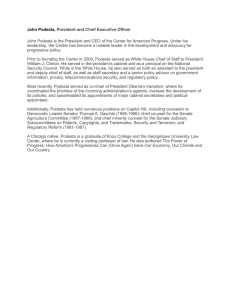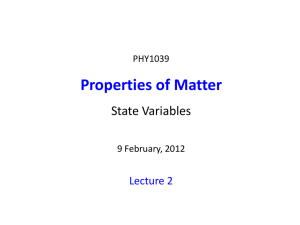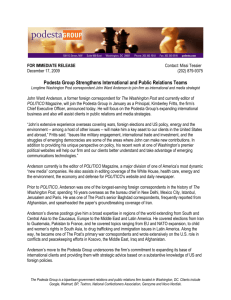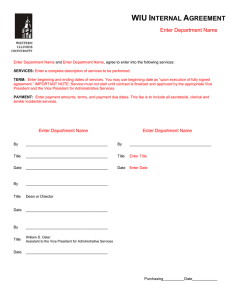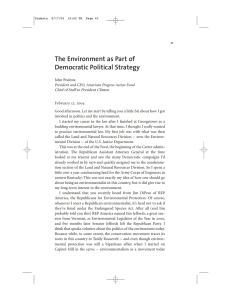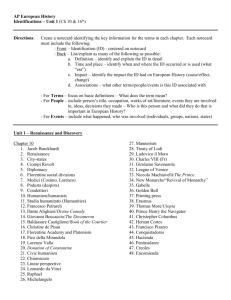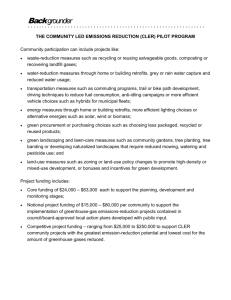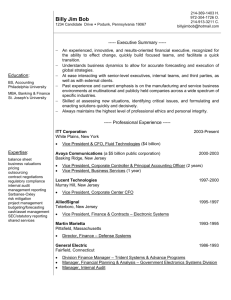Testimony of John D. Podesta at Vice
advertisement
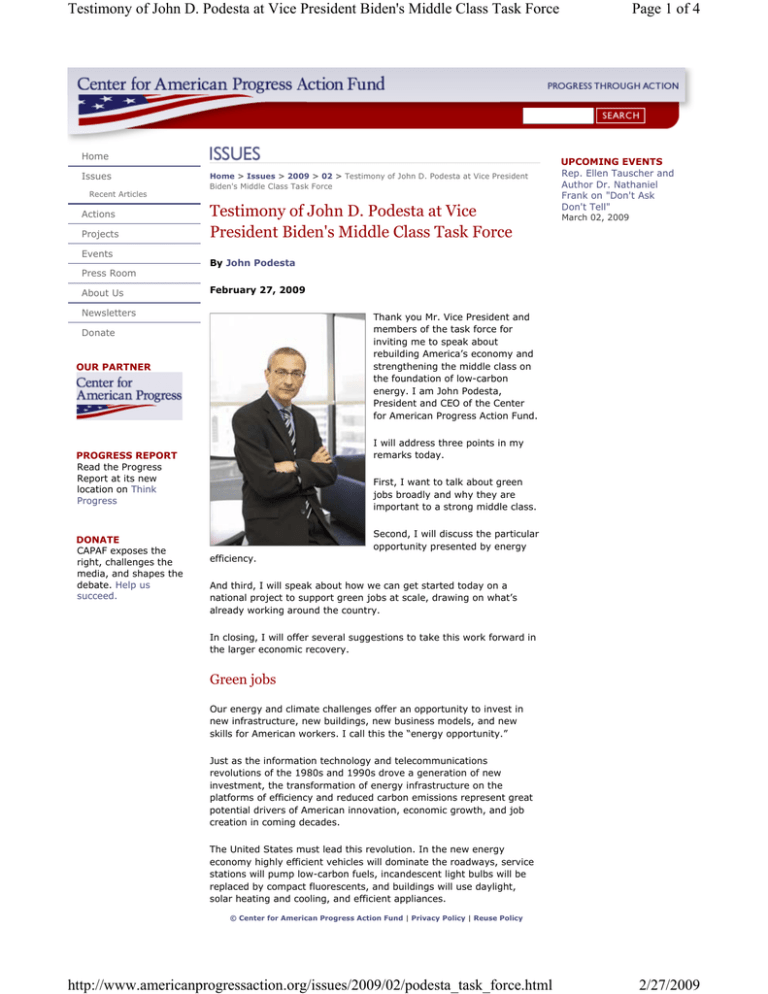
Testimony of John D. Podesta at Vice President Biden's Middle Class Task Force Home Issues Recent Articles Actions Projects Events Press Room About Us Home > Issues > 2009 > 02 > Testimony of John D. Podesta at Vice President Biden's Middle Class Task Force Testimony of John D. Podesta at Vice President Biden's Middle Class Task Force UPCOMING EVENTS Rep. Ellen Tauscher and Author Dr. Nathaniel Frank on "Don't Ask Don't Tell" March 02, 2009 By John Podesta February 27, 2009 Newsletters Thank you Mr. Vice President and members of the task force for inviting me to speak about rebuilding America’s economy and strengthening the middle class on the foundation of low-carbon energy. I am John Podesta, President and CEO of the Center for American Progress Action Fund. Donate OUR PARTNER I will address three points in my remarks today. PROGRESS REPORT Read the Progress Report at its new location on Think Progress DONATE CAPAF exposes the right, challenges the media, and shapes the debate. Help us succeed. Page 1 of 4 First, I want to talk about green jobs broadly and why they are important to a strong middle class. Second, I will discuss the particular opportunity presented by energy efficiency. And third, I will speak about how we can get started today on a national project to support green jobs at scale, drawing on what’s already working around the country. In closing, I will offer several suggestions to take this work forward in the larger economic recovery. Green jobs Our energy and climate challenges offer an opportunity to invest in new infrastructure, new buildings, new business models, and new skills for American workers. I call this the “energy opportunity.” Just as the information technology and telecommunications revolutions of the 1980s and 1990s drove a generation of new investment, the transformation of energy infrastructure on the platforms of efficiency and reduced carbon emissions represent great potential drivers of American innovation, economic growth, and job creation in coming decades. The United States must lead this revolution. In the new energy economy highly efficient vehicles will dominate the roadways, service stations will pump low-carbon fuels, incandescent light bulbs will be replaced by compact fluorescents, and buildings will use daylight, solar heating and cooling, and efficient appliances. © Center for American Progress Action Fund | Privacy Policy | Reuse Policy http://www.americanprogressaction.org/issues/2009/02/podesta_task_force.html 2/27/2009 Testimony of John D. Podesta at Vice President Biden's Middle Class Task Force Page 2 of 4 In this economy, utility companies will profit when customers save energy; a quarter of electricity will come from renewable sources on a “smart grid”; coal-fired power plants will be built to capture carbon dioxide emissions; and businesses of all kinds will factor the cost of carbon into their bottom line and aggressively pursue low-energy options. There is much to be done. And a dialog on green jobs can help us understand the work of building this new economy. A CAP study entitled “Green Recovery” found that investing in energy efficiency and renewable energy creates more jobs than traditional stimulus, and more jobs than traditional fossil fuels. Green investments are more labor-intensive and more local, redirecting money from imported fuel, pollution, and wasted energy to skilled labor, modern infrastructure, and high-tech manufacturing. We send hundreds of billions of dollars overseas each year for imported oil, and green jobs can cut our trade deficit as well. These are familiar jobs in construction, manufacturing, and services spread broadly across the economy. As you look to strengthen and expand the middle class, remember that green jobs are not inevitably good jobs with decent wages and benefits. Federal investment alone is not enough. A new CAPAF report, “Making Contracting Work for the United States,” cautions that too many companies that receive federal contracts treat workers poorly and fail to pay adequate wages or benefits. Federal prevailing wage standards are often below the poverty line and more than 4 million federally contracted workers are low-wage earners with no benefits. To make sure that green jobs are good jobs, we need transparency, oversight, enforcement of the law, and job quality standards. The middle class is not an accident. It is the direct result of rules that protect workers, strengthen communities, and invest in skills and training. Green jobs fit squarely within this strategy for accountable economic development. Energy efficiency Building this new economy will create a range of green jobs: constructing transit, rewiring the grid, growing energy crops, restoring urban habitat, engineering energy systems, and rolling steel for windmill towers. But I want to focus on the specific opportunity of energy efficiency. Buildings create more greenhouse gas emissions than cars or industry, and most energy is used in homes. New building codes help, but we need a strategy to retrofit the buildings that are already standing to cut energy use and emissions. Efficiency is often called the “first fuel.” The cheapest and cleanest energy is the energy you never have to use. This chart shows the relative cost of different forms of energy, and how they change over time with a rising price for carbon. When we finally take action to cap emissions, energy efficiency will make it cheaper, and the benefit will only grow. Energy efficiency is a good investment with tight credit markets. This graph shows the relative risk and return of investments. Treasury bills are low risk and low return. Small company stocks are high risk and return. Energy efficiency offers high returns at very low risk. Global warming is the biggest market failure in history. The “McKinsey Cost Curve” arrays the costs of different ways to cut carbon. Below the line are “negative-cost abatement strategies.” In the business world, we call this “profit.” Today the housing market gives the wrong http://www.americanprogressaction.org/issues/2009/02/podesta_task_force.html 2/27/2009 Testimony of John D. Podesta at Vice President Biden's Middle Class Task Force Page 3 of 4 incentives, and we routinely pass up these profitable efficiency gains. This last chart shows the impact of energy costs on household budgets. Over half of working families’ paychecks just go to housing, transportation, and energy. Families spend more on energy than they do on health care. With millions of people on the edge of loosing their homes, cutting energy costs can help the middle class. What can we do today This brings us to what we can do today. It will take a national commitment to bring energy efficiency to scale—block by block, neighborhood by neighborhood, city by city. And it will take access to capital, new training for workers, and new incentives for homeowners. This is a bold project. The American Recovery and Reinvestment Act makes a big down payment, with $71 billion for clean energy programs—more than three times current spending. This $71 billion includes 4.5 billion for smart grid, $5 billion for weatherization, $3.2 billion for energy conservation block grants, $3.1 billion for state energy offices, and $1 billion more for training through the Green Jobs Act, Youth Build, the WIA adult worker program, and elsewhere. Public investment can prime the pump, but it is not enough. We need to transform the market. Weatherization programs now retrofit about 150,000 homes each year. President Obama has called for 1 million homes—a daunting challenge to scale this much this fast. But with 138 million homes in the country, even at this faster rate, it would take over 100 years to retrofit America. Our boldest goals may not be bold enough to meet the challenge. To scale fast we need to transform the entire market. There are good examples in cities and states that showcase pieces of what it will take. These include: The Cambridge Energy Alliance, which offers customers immediate retrofits with 30 percent-energy savings and no up-front payments. Babylon, NY, uses a revolving loan fund to finance retrofits repaid with energy savings that the city collects on monthly bills. In Delaware, a “Sustainable Energy Utility” can meet energy needs, not by building new power plants but by weatherizing homes or creating a market not only for retrofits, but for the verifiable energy savings they produce. And in Los Angeles, the city is retrofitting public buildings to drive worker training and connect people to new green jobs. A seamless, large-scale national program could follow the lead of these local efforts, including: Policies that drive clean energy demand. Dedicated financing resources. No out-of pocket payments. Repayment through energy cost savings. Accountability for energy savings. Intermediaries to bundle contracts, jobs, and workforce training. http://www.americanprogressaction.org/issues/2009/02/podesta_task_force.html 2/27/2009 Testimony of John D. Podesta at Vice President Biden's Middle Class Task Force Page 4 of 4 Recommendations Mr. Vice President and members of this Task Force, I want to commend you for your foresight in addressing green jobs. This event will build public awareness. But moving forward, I believe we can do more. The American Recovery and Reinvestment Act provides essential resources, that if coordinated could lay groundwork for a coherent national program for jobs in energy retrofits. Such a program must generate new markets, support businesses, and train workers. The Center for American Progress Action Fund would like you to consider encouraging states to use a portion of efficiency funds in the recovery package to establish state revolving loan funds for energy retrofits. This would drive new investment and create a sustained mechanism to finance real projects. I also urge you to coordinate green job training with other energy spending—including $500 million for the Green Jobs Act. Other funds for green job training are found throughout the package for both workforce investment and national service. Further, because many of these ideas have been successfully tested in communities, I ask you to consider convening a group of leading cities and states in a formal partnership, and offering technical support on a cross cutting interagency basis. This network would develop guidance on effective strategies for transforming labor, energy, real estate, and financial markets to create green jobs. I encourage you to establish an interagency working group of senior staff to identify and track funding streams that contribute to a green recovery through workforce investment, building retrofits, and development of strong manufacturing supply chains, including the Department of Energy, the Department of Housing and Urban Development, the Department of Labor, Commerce, Interior, Agriculture, Treasury, the General Services Administration —and others—while creating accountability for results. Finally, to ensure that these efforts shape the economic recovery, this coordination, convening, and planning could be undertaken within three months. Today’s hearing is a very important start, but it is only a start. The nation is at a critical turning point. The decisions you make in coming months will have long lasting effects on the shape of our recovery, and the future of our country. These are a few immediate actions that you can take to support real change. Thank you for the opportunity to speak with you, and for your foresight in holding this hearing. Together, we can rebuild America for clean energy, and create millions of new green jobs. John D. Podesta is CEO and President of the Center for American Progress Action Fund. http://www.americanprogressaction.org/issues/2009/02/podesta_task_force.html 2/27/2009
